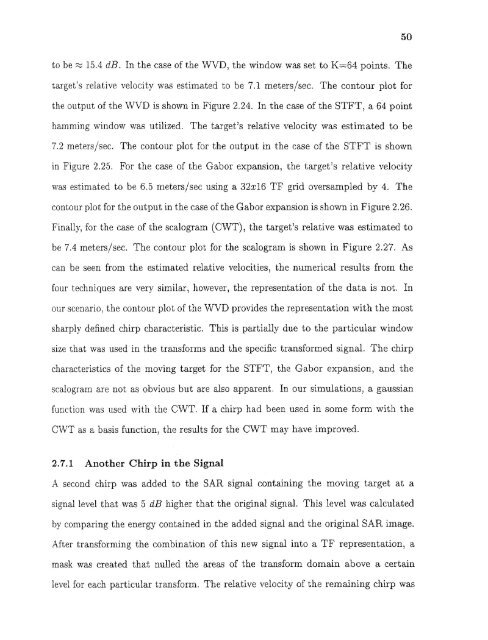Space/time/frequency methods in adaptive radar - New Jersey ...
Space/time/frequency methods in adaptive radar - New Jersey ...
Space/time/frequency methods in adaptive radar - New Jersey ...
Create successful ePaper yourself
Turn your PDF publications into a flip-book with our unique Google optimized e-Paper software.
50to be 15.4 dB. In the case of the WVD, the w<strong>in</strong>dow was set to K=64 po<strong>in</strong>ts. Thetarget's relative velocity was estimated to be 7.1 meters/sec. The contour plot forthe output of the WVD is shown <strong>in</strong> Figure 2.24. In the case of the STFT, a 64 po<strong>in</strong>thamm<strong>in</strong>g w<strong>in</strong>dow was utilized. The target's relative velocity was estimated to be7.2 meters/sec. The contour plot for the output <strong>in</strong> the case of the STFT is shown<strong>in</strong> Figure 2.25. For the case of the Gabor expansion, the target's relative velocitywas estimated to be 6.5 meters/sec us<strong>in</strong>g a 32x16 TF grid oversampled by 4. Thecontour plot for the output <strong>in</strong> the case of the Gabor expansion is shown <strong>in</strong> Figure 2.26.F<strong>in</strong>ally, for the case of the scalogram (CWT), the target's relative was estimated tobe 7.4 meters/sec. The contour plot for the scalogram is shown <strong>in</strong> Figure 2.27. Ascan be seen from the estimated relative velocities, the numerical results from thefour techniques are very similar, however, the representation of the data is not. Inour scenario, the contour plot of the WVD provides the representation with the mostsharply def<strong>in</strong>ed chirp characteristic. This is partially due to the particular w<strong>in</strong>dowsize that was used <strong>in</strong> the transforms and the specific transformed signal. The chirpcharacteristics of the mov<strong>in</strong>g target for the STFT, the Gabor expansion, and thescalogram are not as obvious but are also apparent. In our simulations, a gaussianfunction was used with the CWT. If a chirp had been used <strong>in</strong> some form with theCWT as a basis function, the results for the CWT may have improved.2.7.1 Another Chirp <strong>in</strong> the SignalA second chirp was added to the SAR signal conta<strong>in</strong><strong>in</strong>g the mov<strong>in</strong>g target at asignal level that was 5 dB higher that the orig<strong>in</strong>al signal. This level was calculatedby compar<strong>in</strong>g the energy conta<strong>in</strong>ed <strong>in</strong> the added signal and the orig<strong>in</strong>al SAR image.After transform<strong>in</strong>g the comb<strong>in</strong>ation of this new signal <strong>in</strong>to a TF representation, amask was created that nulled the areas of the transform doma<strong>in</strong> above a certa<strong>in</strong>level for each particular transform. The relative velocity of the rema<strong>in</strong><strong>in</strong>g chirp was
















